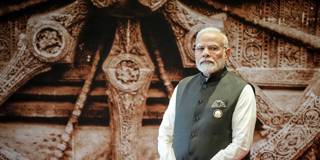Violent Hindu nationalism has accelerated at critical moments when putatively secular politicians have used religion to gain an electoral advantage. This process, a century in the making, is now culminating in Prime Minister Narendra Modi’s open rejection of any pretense of secularism.
PRINCETON – On January 22, Indian Prime Minister Narendra Modi will preside over the consecration of the Ram Temple in Ayodhya, Uttar Pradesh. Executive power will symbolically fuse with the Hindu religion – harking back to myths of Indian rulers as incarnations of Supreme Lord Vishnu – at the former site of the Babri Mosque, demolished by self-styled “angry Hindus” in 1992.
Indian children will celebrate the mythological Lord Ram. State-owned railways have promised to transport more than a thousand trainloads of pilgrims to Ayodhya, boosting tourism-related stock prices. Possibly a hundred private jets will fly in tycoons and notables. This ecstatic moment will cap an unyielding century-long journey to a vision forged by the anarchist ideologue Vinayak Damodar (Veer) Savarkar.
In his 1923 booklet, Hindutva, Savarkar presented an audacious Hindu-centric Indian nationalism. Breaking from the Hindu religion’s message of transcendental equality, he divided the world between friends – those rooted in India through ancestry and devotion to the Fatherland – and all others, who were deemed enemies. (A decade later, the German jurist and prominent Nazi Party member Carl Schmitt advocated the same friend-versus-enemy conception of politics.)

PRINCETON – On January 22, Indian Prime Minister Narendra Modi will preside over the consecration of the Ram Temple in Ayodhya, Uttar Pradesh. Executive power will symbolically fuse with the Hindu religion – harking back to myths of Indian rulers as incarnations of Supreme Lord Vishnu – at the former site of the Babri Mosque, demolished by self-styled “angry Hindus” in 1992.
Indian children will celebrate the mythological Lord Ram. State-owned railways have promised to transport more than a thousand trainloads of pilgrims to Ayodhya, boosting tourism-related stock prices. Possibly a hundred private jets will fly in tycoons and notables. This ecstatic moment will cap an unyielding century-long journey to a vision forged by the anarchist ideologue Vinayak Damodar (Veer) Savarkar.
In his 1923 booklet, Hindutva, Savarkar presented an audacious Hindu-centric Indian nationalism. Breaking from the Hindu religion’s message of transcendental equality, he divided the world between friends – those rooted in India through ancestry and devotion to the Fatherland – and all others, who were deemed enemies. (A decade later, the German jurist and prominent Nazi Party member Carl Schmitt advocated the same friend-versus-enemy conception of politics.)